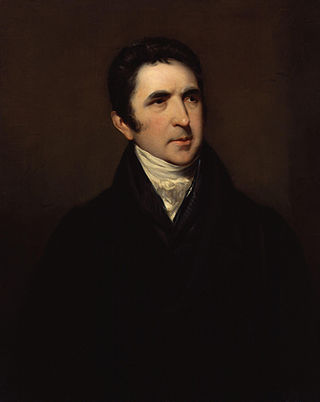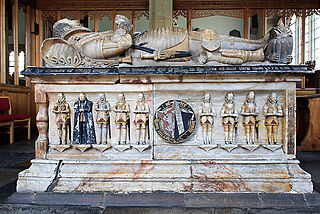Laforey baronets, of Whitby (1789)

- Sir John Laforey, 1st Baronet (c. 1729–1796)
- Sir Francis Laforey, 2nd Baronet (1767–1835)
The Laforey Baronetcy, of Whitby in the County of Devon, was a title in the Baronetage of Great Britain. It was created on 2 December 1789 for the naval commander John Laforey. He was succeeded by his son, the second Baronet. He was an Admiral in the Royal Navy. He was childless and the title became extinct on his death in 1835.


Marquess of Linlithgow, in the County of Linlithgow or West Lothian, is a title in the Peerage of the United Kingdom. It was created on 23 October 1902 for John Hope, 7th Earl of Hopetoun. The current holder of the title is Adrian Hope.

Earl Peel is a title in the Peerage of the United Kingdom. The Peel family descends from Robert Peel, eldest son of a wealthy cotton merchant. The family lands, known as Drayton Manor, in the County of Stafford would become more commonly known in modern-day as an amusement park. The family seat is Elmire House, near Ripon, North Yorkshire.

Earl of Gosford is a title in the Peerage of Ireland. It was created in 1806 for Arthur Acheson, 2nd Viscount Gosford.

Lord Sempill is a title in the Peerage of Scotland. It was created in circa 1489 for Sir John Sempill, founder of the collegiate Church of Lochwinnoch. Sempill was killed at the Battle of Flodden in 1513. His grandson, the third Lord, was known as "The Great Lord Sempill". His grandson, the fourth Lord, was Ambassador from King James VI of Scotland to Spain in 1596. The male line failed on the death of his great-grandson, the eighth Lord, in 1684. He was succeeded by his sister Anne, wife of Robert Abercromby, who in 1685 was created Lord Glassford for life. In 1688 she obtained a new charter settling the lordship of Sempill in default of male issue, upon her daughters without division by her then and any future husband. Her younger son, the twelfth Lord, commanded the left wing of the government army at the Battle of Culloden in 1746.

Earl of Minto, in the County of Roxburgh, is a title in the Peerage of the United Kingdom. It was created in 1813 for Gilbert Elliot-Murray-Kynynmound, 1st Baron Minto. The current earl is Gilbert Timothy George Lariston Elliot-Murray-Kynynmound, 7th Earl of Minto.

Viscount Wimborne, of Canford Magna in the County of Dorset, is a title in the Peerage of the United Kingdom.

Viscount Thurso, of Ulbster in the County of Caithness, is a title in the Peerage of the United Kingdom. It was created on 11 June 1952 for the Scottish Liberal politician and former Secretary of State for Air, Sir Archibald Sinclair, 4th Baronet. His son, the second Viscount, served as Lord Lieutenant of Caithness from 1973 to 1995.

Viscount De L'Isle, of Penshurst in the County of Kent, is a title in the Peerage of the United Kingdom. It was created in 1956 for William Sidney, 6th Baron de L'Isle and Dudley, VC, KG, GCMG, GCVO (1909–1991).

Lord Aylmer, Baron of Balrath, in the County of Meath, is a title in the Peerage of Ireland. It was created in 1718 for the naval commander Matthew Aylmer, the second son of Sir Christopher Aylmer, 1st Baronet, of Balrath. Lord Aylmer's son, the second Baron, represented Rye in the House of Commons. The latter's grandson, the fourth Baron, succeeded his kinsman as seventh Baronet, of Balrath, in 1776. The titles remain united. He was succeeded in both titles by his son, the fifth Baron. He was a general in the Army and served as Governor General of Canada from 1830 to 1835. Lord Aylmer assumed by Royal licence the additional surname of Whitworth in 1825 on the death of his uncle Charles Whitworth, 1st Earl Whitworth. On his death, the titles passed to his younger brother, the sixth Baron. He was an admiral in the Royal Navy.

Baron Ashburton, of Ashburton in the County of Devon, is a title that has been created twice, once in the Peerage of Great Britain and once in the Peerage of the United Kingdom. Since 1835, the title has been held by members of the Baring family.

The HaringtonBaronetcy, of Ridlington in the county of Rutland, is a title in the Baronetage of England. It was created on 29 June 1611 for James Harington. He was a descendant of John Harington, one of the Barons summoned to Parliament by Edward II. James's elder brother was John Harington, 1st Baron Harington of Exton. The second Baronet was a Royalist during the English Civil War. The third Baronet was a Major-General in the Parliamentarian Army and one of the judges appointed to try Charles I, although he refused to sit. He was nonetheless excepted from the Indemnity and Oblivion Act and his title was forfeited for life in 1661. The ninth, eleventh, and twelfth Baronets were all judges. The family is one of two families to have produced three County Court judges.

Baron Haversham is a title that has been created twice, once in the Peerage of England and once in the Peerage of the United Kingdom. Both creations are extinct. The first creation came on 4 May 1696, when Sir John Thompson, 1st Baronet was created Baron Haversham, of Haversham in the County of Buckingham, in the Peerage of England. He had formerly been member of parliament for Gatton and had already been created a Baronet, of Haversham in the County of Buckingham, in the Baronetage of England in 1673. His son, the second Baron, sat as Member of Parliament for Bletchingley and Gatton, before inheriting the title. He had no sons and the barony became extinct on his death on 11 April 1745.
Admiral Sir Francis Laforey, 2nd Baronet, KCB was an officer of the British Royal Navy during the French Revolutionary and Napoleonic Wars, whose distinguished service record included numerous frigate commands in Home waters and in the West Indies. He is best known however for his service in command of the ship of the line Spartiate at the Battle of Trafalgar in 1805. During the action, Laforey was heavily engaged and his ship suffered heavy casualties. Five years after Trafalgar, Laforey was promoted to rear-admiral and commanded the Leeward Islands squadron, before retiring in 1814.

There have been seven baronetcies created for persons with the surname Parker, three in the Baronetage of England, two in the Baronetage of Great Britain and two in the Baronetage of the United Kingdom. Two of the creations are extant as of 2008. Though none of the different families of baronets were related, several supplied a number of flag officers to the Royal Navy.

There have been two baronetcies created for persons with the surname Barrow, one in the Baronetage of Great Britain and one in the Baronetage of the United Kingdom.

There have been two baronetcies created for members of the Salusbury family, the first in the Baronetage of England and the second in the Baronetage of Great Britain. Neither title has survived to the present day although the senior baronetcy is technically considered to be dormant.
Admiral Sir John Laforey, 1st Baronet was a senior and controversial British naval officer of the 18th century whose extensive career was spent mainly on the North American and West Indian stations. During his career, Laforey was repeatedly involved in contentious naval politics, especially relating to the provision of prize money and angered several senior officers through much publicised disputes. This resulted in his sidelining for much of his career, only making flag rank and finding success with the outbreak of the French Revolutionary Wars in 1793.

There have been two baronetcies created for persons with the surname Leicester, both in the Baronetage of England. The fifth Baronet of the second creation was raised to the peerage as Baron de Tabley in 1826. Both the barony and the two baronetcies are now extinct.
Anthony James Pye Molloy was an officer of the Royal Navy. He served during the American War of Independence and the French Revolutionary Wars.
Laforey is a surname. Notable people with the surname include: